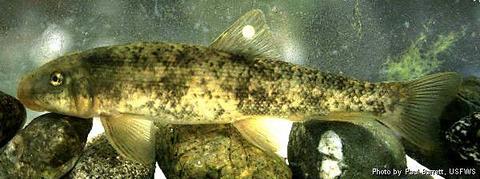
Though there are no sardines in the Santa Ana River, there were more than 150 scientists who gathered for the 2nd annual symposium on native species in that important local waterway at UCR on Oct. 22.
The river provides roughly 75% of San Bernardino Valley’s water supply, so maintaining its ecosystem is a hot topic for experts from nearby state and county water agencies, private consulting firms and universities. All have an acute interest in protecting the river’s ecosystem health.
“Humans and wildlife place a lot of competing demands on this river,” said symposium co-organizer Kurt Anderson, an associate professor in UCR’s Department of Evolution, Ecology and Organismal Biology. “Human activities can sometimes compromise the health of native fish and vegetation.”
Similar to the Los Angeles River, there have been measures taken to prevent the Santa Ana River from flooding. However, Anderson explained that occasional floods are good, even necessary for natural ecosystems.
“A lot of endangered species are dependent on environments created by the sediment that river floods deposit,” he said. “For example, kangaroo rats live in areas that historically have flooded every few decades. By changing the river flow, we don’t get floods anymore, and the species that were dependent on them are going away. The kangaroo rat is endangered now.”
One goal of the symposium is to help professionals discuss plans for controlled flooding in specific areas to help restore these native habitats, as well as other strategies for protecting native fish and flora.
Sponsored by the San Bernardino Valley Municipal Water District, ICF International and Stillwater Sciences, the symposium featured more than 20 presentations as well as a poster session. Topics included results of studies on the health of the river’s vegetation, fish and water levels, and strategies for treating wastewater that don’t negatively impact the environment.
UCR is involved heavily in studying the habitat of the endangered Santa Ana Sucker fish, which is a main focus in Anderson’s lab. “I was excited to help bring the symposium to UCR so that our science can inform solutions for protecting these fish,” he said.
Sucker fish scrape algae and microorganisms off rocks. “They’re an important part of the food chain — that we do know — but there’s a lot about how they interact with insects and other parts of the ecosystem that we still don’t know,” Anderson said.
One student presentation focused on the wealth of invasive fish in the river such as bass, catfish, and sunfish, which are potentially crowding out the native sucker fish, or even eating them.
“A lot of native species, you don’t know how important they are until they’re gone,” Anderson said. “We have a lot of research to do still on how they function, but it’s always true that native species are adapted to and an important part of any ecosystem.”
For those interested in learning more, all presentations from the symposium are available on the Upper Santa Ana River Habitat Conservation Plan website.
